How to protect sorrel from pests and diseases, what folk remedies and chemicals to treat
Sorrel pests and diseases can cause significant damage to tasty and healthy greens, which are among the first to appear on our table in spring. Most often, delicate leaves are spoiled by leaf-eating insects, which leave numerous holes. With improper care, sorrel suffers from various fungal infections. To save the beds from adversity, you need to identify the pest and carry out an insecticidal or fungicidal treatment. And proven folk methods will help in this.
Reasons for the appearance of holes on sorrel
Sorrel is a relatively hardy crop that many pests bypass. However, there are those who are not averse to eating delicious greens. Sorrel holes are caused by:
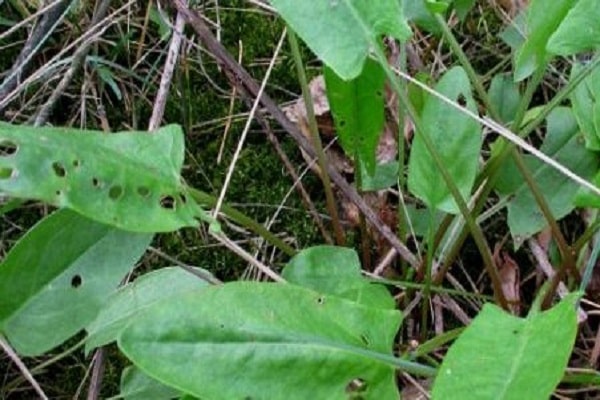
- leaf beetle;
- bear;
- aphid;
- slugs;
- winter scoop;
- sorrel sawfly.
If holes are found on the leaves, the pest should be identified and the sorrel should be treated with any of the available folk methods. All recipes for such "treatment" are absolutely safe for human health, so greens can be safely eaten literally a few days after spraying.
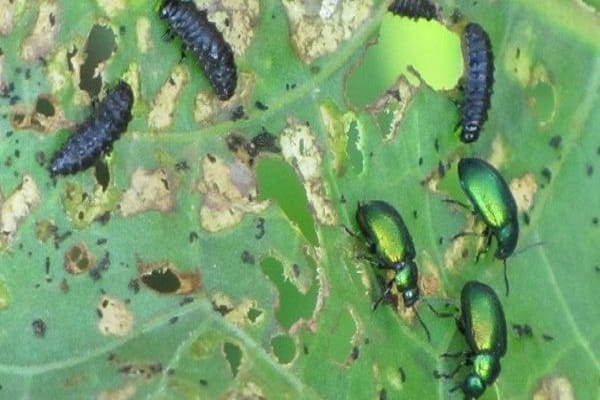
But the same cannot be said about chemical insect control agents. Ready-made insecticides should be used only in extreme cases, when safe methods have proved to be ineffective. After spraying with chemistry, sorrel cannot be used in cooking for 3-4 weeks: the waiting period and the beginning of the next harvest depends on the toxic component, and is always indicated on the insecticide packaging.
Important! 2-3 days after treatment with chemicals, oxalic greens must be cut and disposed of, and then wait for a new harvest. However, it will grow quickly enough.

Sorrel pests and methods of protection against them
Pest control methods include hand-picking adults, setting traps, and spraying with compositions prepared according to folk recipes.
Leaf beetle
If small bugs of a black-green shiny color and 5-10 millimeters in size are found on a perforated sorrel, it means that the bed was attacked by leaf beetles. They hibernate in the ground, and with the arrival of spring they begin to actively multiply and eat crispy greens. A favorite place for laying eggs is the underside of the leaves. In one season, females make 2-3 clutches, thereby increasing the number of pests exponentially.
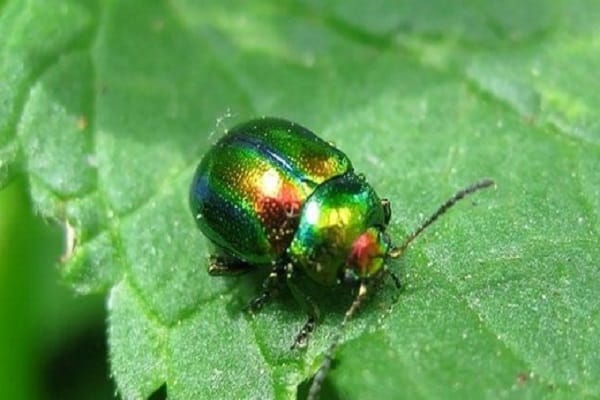
Advice! As a preventive measure for a leaf beetle attack, it is useful to plant pyrethrum bushes (Persian, maiden or Dalmatian chamomile) next to the sorrel beds. This unpretentious perennial will decorate a summer cottage and scare away insatiable pests.
There are several ways to fight the leaf beetle:
- Dust the leaves with a mixture of wood ash and tobacco dust. Take both components in equal proportions, mix and dust the culture daily for 4-5 days.
- Spray the sorrel with a soapy garlic solution. To do this, dissolve shavings of one bar of laundry soap (72%) in 3 liters of water, add chopped cloves, tops or green garlic arrows, leave for 10-12 hours, strain and use as directed. After that, sorrel can be eaten for 2-3 days, only before serving it should be thoroughly washed.
- Treat the leaves with a "hot" mixture. Combine 1 cup of wood ash, 1 tablespoon of dry mustard powder and the same amount of freshly ground black pepper (it is better to grind the peppercorns yourself).
So that in the future there are no problems with pests, it is recommended to dig up the sorrel beds every autumn to a depth of 20 centimeters and not forget about removing weeds.
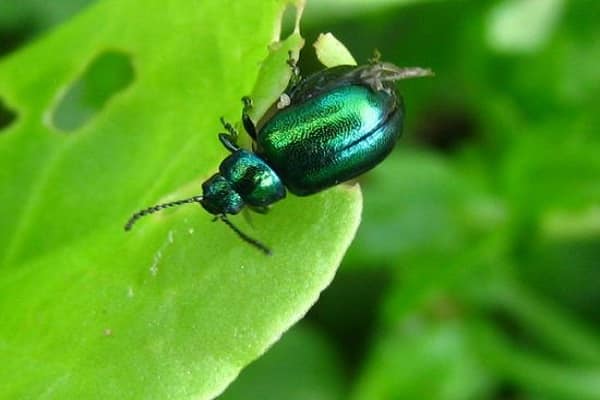
Wireworms
The clicker beetle is not afraid of the sorrel. But its thin caterpillars up to 1.5 centimeters long, living in the ground and feeding on roots, cause significant harm to plants. The easiest way to save crops is to remove weeds in a timely manner. It is useful to transplant sorrel every year to a new place or to process the site with lime: the larvae of the pest live only in acidic soil and are not able to exist in an alkaline environment.
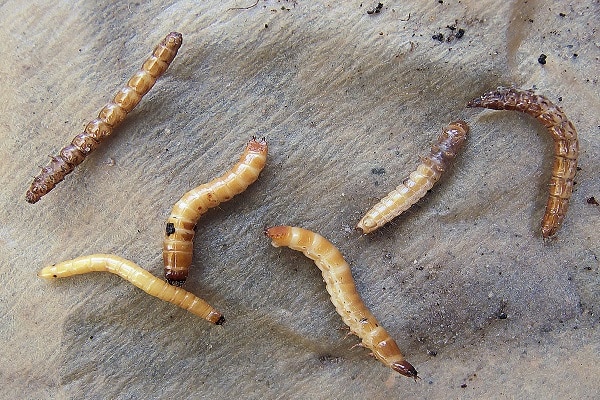
Medvedka
If the sorrel bushes began to dry out, and under mechanical action, they can easily be pulled out of the soil, it means that the most malicious pest of garden plants has wound up in the garden. But against the bear there are several effective folk remedies:
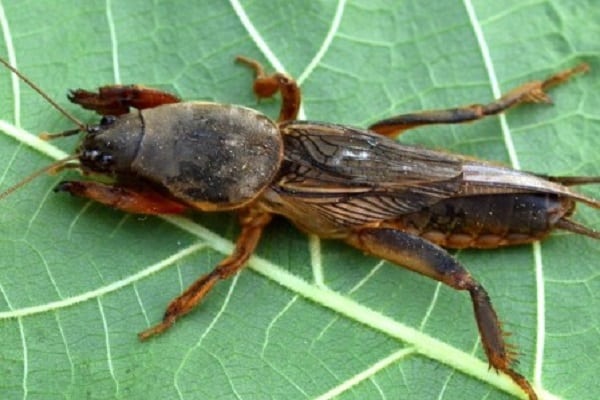
- Pour 1-2 liters of soap solution into the bear's hole, catch and neutralize the jumped out insect.
- Dig into a tunnel dug in the ground, a glass half-liter jar with the neck up. Moving along the usual route, the pest will certainly end up at the bottom of the trap.
- In the area with sorrel, close up crushed eggshells, flavored with aromatic sunflower oil. Such a "delicacy" will be fatal for the bear, but will serve as a fertilizer for plants.
- Plant chrysanthemums, coriander, basil, marigolds or marigolds between rows.
- Sprinkle the sorrel with onion peel infusion.
If none of the above methods helped to get rid of the bear, you will have to resort to a radical method - use chemical insecticides (Fenaxin plus, Rembek, Boverin, Medvetsid, Anti Medvedka).
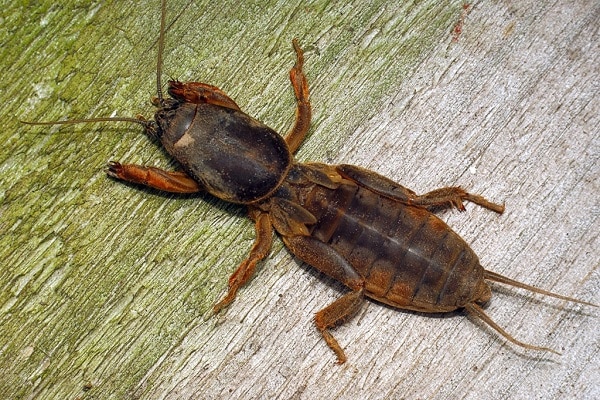
Naked slugs
On the leaves of sorrel, slugs leave not only holes, but also silvery traces. Single pests can be easily collected by hand or lured into a "beer" trap - any low container with poured beer or other fermented drink.
You can save greens from the pest in other ways:
- Spread narrow strips of wood ash, broken eggshells, lime or superphosphate between the rows.
- Spray the sorrel with ammonia (10%).
- In the evening, put a metal sheet or wooden board on wet soil, and in the morning, collect the crawling slugs from the bottom of the trap.
Naked slugs like to hide under plant debris, so it is important to remove excess organic matter from the garden in time.
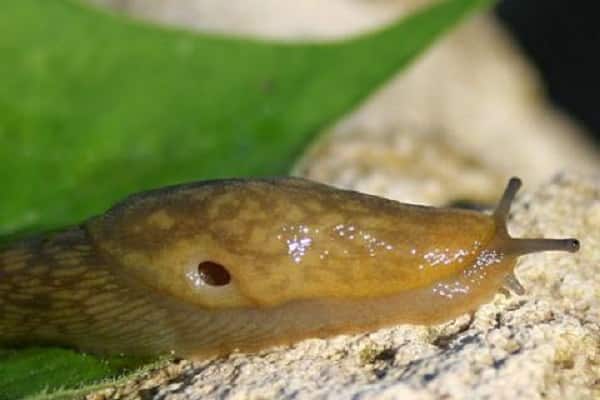
Aphid
The aphid colony sucks the juices out of the sorrel, causing the greens to wither, the roots weaken, and the culture dies. To get rid of small black or green bugs, it is enough to spray the area one or more times with any of the decoctions:
- tobacco;
- onion peel;
- garlic;
- tomato tops;
- burdock;
- dandelion.
Sorrel beds can be dusted with tobacco dust or wood ash.An effective insecticidal agent is an infusion of ash, combined with dissolved shavings of laundry soap (72%): 1-2 treatments with such a composition will save the garden from aphids for a long time.
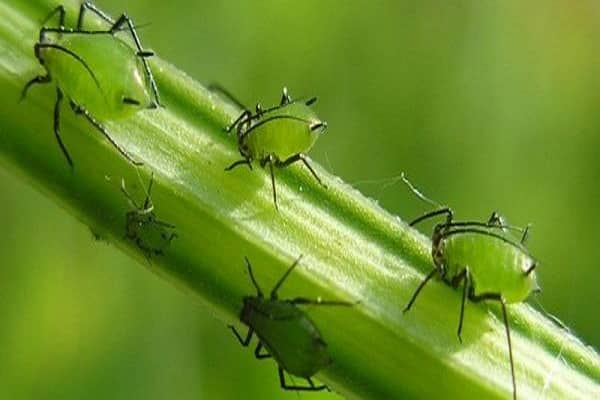
Winter scoop
Prevention of the appearance of winter scoops - autumn digging of the site and timely removal of weeds. But if grayish-brown butterflies have already appeared on the leaves of sorrel, reaching a length of 2-3 centimeters, spraying with burdock infusion will help. To prepare it, pour half a bucket of freshly cut chopped leaves with water and leave for 72 hours.
To get rid of the voracious caterpillars of the scoop, namely, they gnaw huge holes in the leaves, you need to spray the sorrel beds every other day for a week.
Adults can be caught using fragrant baits: at a height of 1 meter from the ground, hang open containers with sweet or fermented foods. Trapped moths will no longer be able to lay eggs and give birth to a new generation of voracious caterpillars.
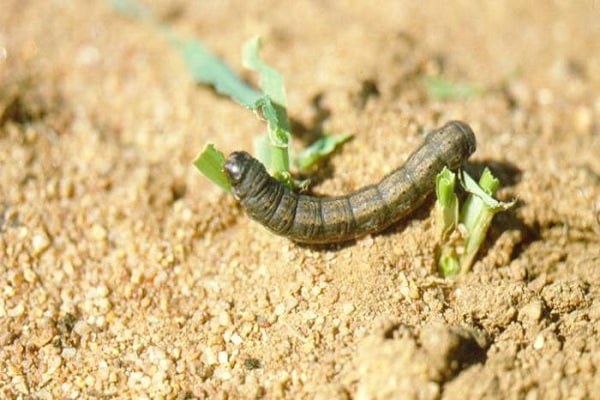
Sorrel sawfly
2-3 generations of the sorrel sawfly, which appear during the summer, attack the sorrel and eat its juicy foliage, can leave only solid veins from the garden by autumn. If the sawfly caterpillars have managed to attack the culture, the easiest way is to spray the greens with a decoction of chamomile, mixed with a solution of laundry soap. Spraying frequency - once a week.
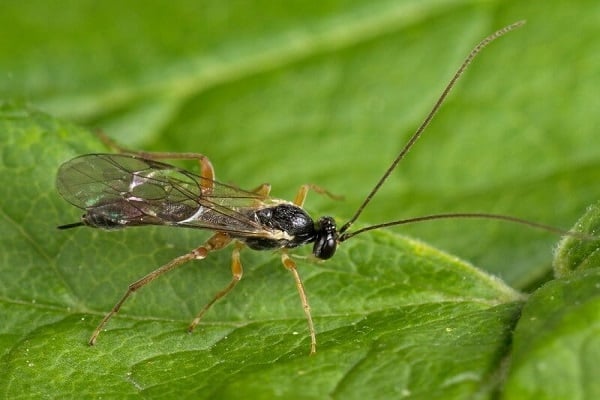
Treatment of grass diseases
Each sorrel disease has its own recipes. The list of ailments affecting leaf culture is large, but this does not mean that all of them threaten to simultaneously damage green beds. Each disease has its own characteristic signs and methods of struggle.
Powdery mildew
The main symptoms of the disease: a whitish-gray bloom on the surface of the leaf plates, which eventually darkens and becomes brown. Leaves heavily affected by the fungus turn black and die off, and the sorrel bushes weaken and freeze in winter. You can get rid of the harmful fungus by spraying with various formulations:
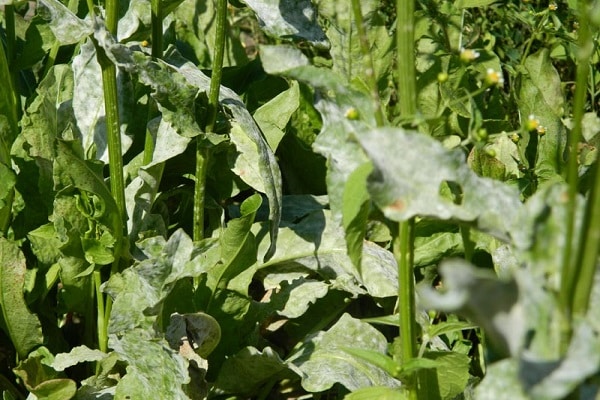
- Dilute milk whey with cold water in a ratio of 1:10.
- Pour a bucket of chopped weeds with hot water so that it covers all the vegetation. Ferment for several days, strain and use for sorrel processing.
- Pour half a glass of wood ash into 1 liter of boiling water, leave for 48 hours, add a little laundry soap to the solution. Spray twice, at intervals of 5-7 days.
Prevention of the spread of powdery mildew, as well as other fungal diseases, is the observance of crop rotation, timely removal of plant residues, feeding with phosphorus and potassium fertilizers.
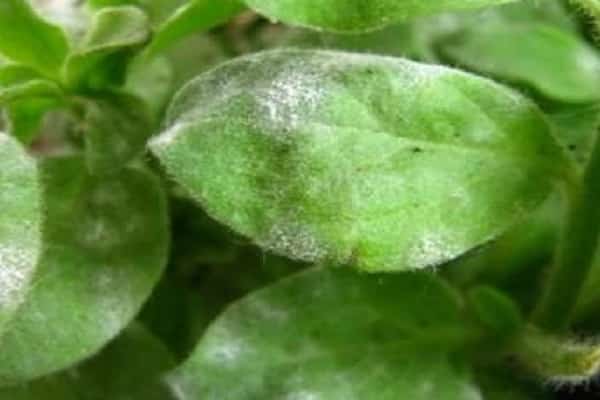
Downy mildew
Peronosporosis, as downy mildew is also called, can be identified by the numerous yellow spots that cover the leaves of the sorrel. On the underside of the greenery, you can see a gray-purple bloom. Symptoms usually appear in June. Only ready-made fungicides are capable of effectively fighting infection: Vitaros, Skor, Previkur.
From folk recipes, you can try to spray the beds with a solution of dry mustard (1 tablespoon of powder per 5 liters of water) or rotted cow dung (1 part organic matter per 3 parts water).

White spot
This fungal disease is manifested by numerous dark spots, the center of which turns white over time. It is very difficult to save sorrel, completely covered with specks of white color. The easiest way is to mow and burn diseased greens, treat the beds with Bordeaux liquid (1%) or any ready-made fungicide.

Rust
Signs of rust are yellow-orange swollen patches (pustules) affecting the petioles and leaves of sorrel. When cracked, fungus spores, similar to a rust-colored powder, spill out of them.Redness of sorrel should be a signal to fight rust, and a mixture of copper (5 grams) vitriol, 100 grams of laundry soap shavings and 5 liters of water will help. The composition must be sprayed onto the beds every day for a week, doing 2 treatments a day.
A potassium permanganate solution obtained from 5 grams of potassium permanganate and 10 liters of water is also suitable as a fungicide. You need to use it daily for 7 days.
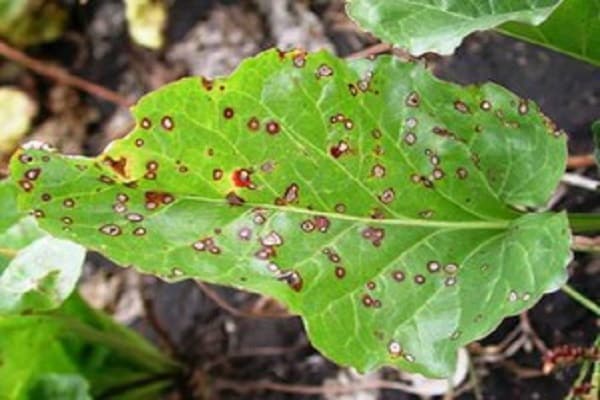
Ovulariasis
This fungal disease affects only sorrel. When infected, gray-brown or yellow-brown spots appear on the surface of the leaves with a dark purple border around the edges. Gradually, the spots increase in size, merge and lead to drying of the leaves. It will not be possible to save the crop with ovulariasis: you will have to cut and dispose of diseased greens, and treat the beds with Fitoverm or another suitable fungicide. After the healthy leaves grow back, the sorrel will be quite suitable for food.
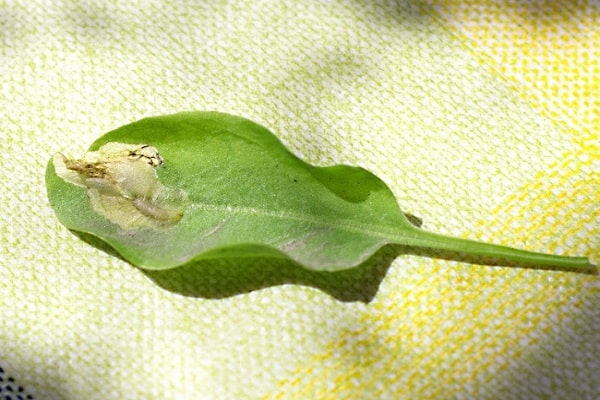
Gray rot
The main symptom of the disease is a gray "fluffy" plaque on the leaf surface. It appears at low temperatures and high soil moisture. With a slight degree of damage, it is recommended to spray sorrel with a solution prepared from 1 cup of wood ash, 1 cup of ground chalk, 1 teaspoon of copper sulfate and 10 liters of water.
In case of severe damage to gray rot, you will have to spray the beds with Bordeaux liquid or chemical fungicides.
Advice! If folk methods are ineffective against fungal infections, you will have to purchase biofungicides (Fitosporin-M, Planriz, Hamair, Alirin-B, Trichodermin, Pseudobacterin-2) and apply according to the instructions. These preparations contain live bacteria that are safe for human health, but destructive for pathogenic fungi and their spores.
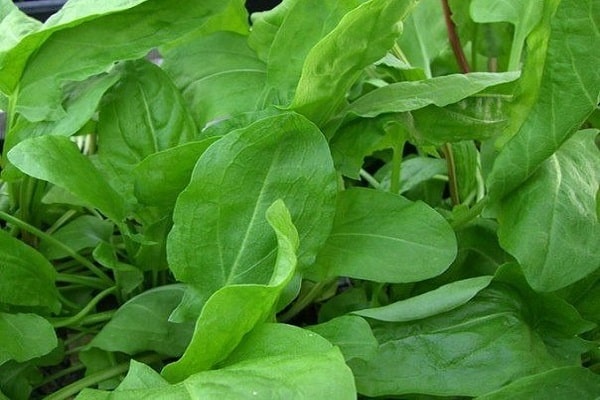



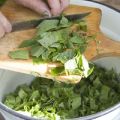



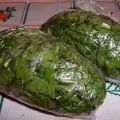


A very good sensible article. Many thanks. Found the answers to all the questions.
Good day!
Thank you very much for your good feedback, we are always happy to help!
If you have any questions, write, we are always in touch.